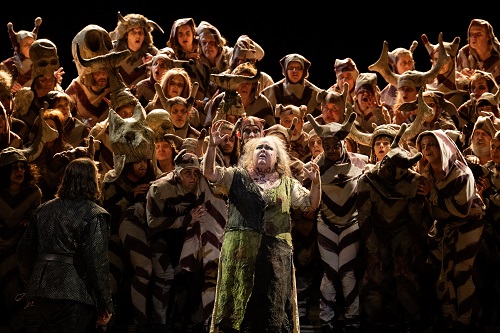
***
This intriguing Adele Thomas direction of Verdi’s Il Trovatore has at its core the horrific damage done to the so-called witch Azucena and her quest to fulfil her mother’s demand at the stake for vengeance. Our eyes may be drawn to the quasi-Medieval teeth snarling stylised mask that opens and closes like the jaws of hell to open and close the action. But unless my eyes are playing tricks on me the actual set is a vast picture frame with the words My Revenge in Italian on its upper edge. If it wasn’t, it perhaps should have been. (I can now confirm it said My Vengance, in Italian)

Jamie Barton
In an opera that famously requires four great singers the finest performance was from Jamie Barton as Azucena, finding anger and despair, gripping emotion in every line. This was as powerful and gut-wrenching a performance as you could wish for – and she certainly looked the part. Yes, a victim but also a strong woman, physically too as she pulls away from her captors’ ropes as conductor Antonio Pappano drives the fabulous frenzy in the pit. This is a captivating mezzo with delicious lower tones and spine-tingling dramatic oomph.
Our lovers Leonora and Manrico excel with the vocal demands both in their vast solo arias and duets, now rising on the luscious playing from the orchestra and sensitive lighting on the simple Annemarie Woods set. These minutes of rapture and despondency transcend the horror and visual evil we see on the stage. Gregory Kunde is a heroic and fervent Manrico, not really dashing but never tiring and always secure. Rachel Willis-Sorensen is allowed to take to an empty stage, again elegantly lit, for her crystal cut soprano effervescent splendours.

Ludovic Tezier
The Count, sublimely sung by Ludovic Tezier, in his luxurious golden outfit, may have good cause to lose his reason but fortunately he did not lose his control of performing this dastardly role. Speaking on dastardly, the wonderful villain of the piece, his henchman Ferrando, sung by Roberto Tagliavini, seems almost an Iago figure delighting in just everybody’s anguish. His (slightly annoying) part human, part beast, horned, dancing creatures accompany him and sheepdog like corral the troops and nuns alike. The off-stage chorus singing is ethereal.

Roberto Tagliavini
The armies are portrayed as either knees-knocking Holy Grail-type medieval buffoons hiding behind their large shields or, for Manrico’s band, more grotesque animalistic warriors.
The chorus set pieces are sung superbly and even having these odd characters pop up through the ubiquitous trap doors during the Anvil Chorus and cavort and somersault up and down the monumental stairs that are the set cannot take away the delight.
There are some rather silly things, such as the stray limbs that litter the steps in the torture chamber sliding off the stage (we could have Thing from the Adams Family crawling off), but it certainly this quasi Hieronymus Bosch inspired theme is of theatrical interest and generally does not hinder the performers doing what they do best, and here their very best, sing.
At the Royal Opera House until 2 July.
Images: Camilla Greenwell
https://www.roh.org.uk/tickets-and-events/il-trovatore-by-adele-thomas-dates
Images: Camilla Greenwell